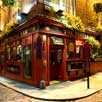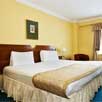Dublin
Dublin is the largest city in Ireland and is also the capital. With Georgian architectural elegance, a famous pub culture and fantastic museums and galleries, this seaside location easily lives up to its huge reputation. With an evident way with words, reflected in the city’s designation as a Unesco City of Literature, quaint cobbled streets and interesting tourist attractions, Dublin is somewhere you should add to your travel bucket list.
Due to its proximity to Britain, Dublin was the most important city in Ireland during the Tudor conquest of Ireland and subsequent British Invasions until after 1922 when the Irish Free State was formed. As the British held a presence here for over 500 years, most of the historic buildings from the 1500s on were built by them.
Orientation
Dublin is divided by the River Liffey. On the north side of the Liffey is O'Connell Street, the main thoroughfare, which is intersected by numerous shopping streets, including Henry Street and Talbot Street. On the south side are St. Stephen's Green, Grafton Street, Trinity College, Christ Church, St. Patrick's Cathedrals, and many other attractions.
Dublin postcodes range from Dublin 1 to Dublin 24. As a rule, odd numbers are given to areas north of the River Liffey, while even numbers are given to areas south of the river. Usually, the lower the postcode, the closer to the city centre.
If you're already in the city, the main tourist office, located in St. Andrew's Church just off Grafton Street in the city centre (Dublin 2), is a good place to start for information. You can book accommodation and tours there, as well as find general information on where to go and what to do.
Although some of Dublin's finest Georgian architecture was demolished in the mid-20th century, a remarkable amount remains. They were a reminder of the past British imperialism and were pulled without regard to their beauty and architectural significance. They were replaced with modernist or pastiche office blocks, St. Stephen's Green (Dublin 2) being a prime example. Thankfully, attitudes have changed significantly, and Dubliners are now rightly proud of their impressive buildings from all eras.
Attractions
Among the main attractions in Dublin are Dublin Castle, the seat of British rule in Ireland until 1922, Phoenix Park, one of the largest inner city parks in the world, The General Post Office, one of Ireland's most famous buildings due to the 1916 Easter rising, Kilmainham Gaol, a former prison turned museum that held and executed the rebels of the 1916 Rising and Trinity College, where the Book of Kells and the Book of Durrow are held. For further information, please go to our Tourist attractions in Dublin page.

Image: Ha'penny Bridge, Dublin
Quarters
Dublin city is divided into several quarters or districts.
Medieval Quarter - This is the oldest part of the city, which includes Dublin Castle, Christ Church and St Patrick's Cathedral along with the old city walls. It was part of the Dubh Linn settlement, this area became the home for the Vikings in Dublin.
Georgian Quarter - Dublin is renowned for its Georgian architecture. It boasts some of the world's finest Georgian buildings. It starts at St Stephen's Green and Trinity College up to the canal. Merrion Square, St Stephen's Green and Fitzwilliam Square are examples of this style of architecture.
Docklands Quarter - This area is Dublin Docklands which includes "Silicon Docks", Dublin's Tech Quarter located in the Grand Canal Dock area. Global giants such as Google, Facebook, Accenture and Twitter are based there. It used to be a derelict part of the city, but has undergone revitalisation with the development of offices and apartments.
Cultural Quarter - Temple Bar is at the heart of Dublin's social and cultural life. It was once derelict but was then revitalised in the 1990s.
Creative Quarter - It is the second newest district, created in 2012. It covers the area from South William Street to George's Street, and from Lower Stephen's Street to Exchequer Street. Its a hub of design, creativity and innovation.
Dublin One District - This is Dublin's newest district which is located Northside stretching from O'Connell Street to Capel Street and Parnell Square to the quays. It includes attractions such as the GPO and Hugh Lane Gallery. For further information, see www.dublin-one.ie
Landmarks
Dublin has many landmarks and monuments dating back hundreds of years. One of the oldest is Dublin Castle, which was first founded as a major defensive work on the orders of England's King John in 1204, shortly after the Norman invasion of Ireland in 1169, when it was commanded that a castle be built with strong walls and good ditches for the defence of the city, the administration of justice, and the protection of the King's treasure. Largely complete by 1230, the castle was of typical Norman courtyard design, with a central square without a keep, bounded on all sides by tall defensive walls and protected at each corner by a circular tower. Sited to the south-east of Norman Dublin, the castle formed one corner of the outer perimeter of the city, using the River Poddle as a natural means of defence.
One of Dublin's newest monuments is the Spire of Dublin, or officially titled "Monument of Light". It is a 121.2-metre (398 ft) conical spire made of stainless steel and is located on O'Connell Street. It replaces Nelson's Pillar and is intended to mark Dublin's place in the 21st century. The spire was designed by Ian Ritchie Architects, who sought an "Elegant and dynamic simplicity bridging art and technology". During the day it maintains its steel look, but at dusk the monument appears to merge into the sky. The base of the monument is lit and the top is illuminated to provide a beacon in the night sky across the city.
Many people visit Trinity College, Dublin to see the Book of Kells in the library there. The Book of Kells is an illustrated manuscript created by Irish monks circa. 800 AD. The Ha'penny Bridge; an old iron footbridge over the River Liffey is one of the most photographed sights in Dublin and is considered to be one of Dublin's most iconic landmarks.
Other popular landmarks and monuments include the Mansion House, the Anna Livia monument, the Molly Malone statue, Christ Church Cathedral, St Patrick's Cathedral, Saint Francis Xavier Church on Upper Gardiner Street near Mountjoy Square, The Custom House and Áras an Uachtaráin. The Poolbeg Towers are also iconic features of Dublin and are visible in many spots around the city.
Parks
Dublin has more green spaces per square kilometre than any other European capital city, with 97% of city residents living within 300 metres of a park area. The city council provides 2.96 hectares (7.3 acres) of public green space per 1,000 people and 255 playing fields. The council also plants approximately 5,000 trees annually and manages over 1,500 hectares (3,700 acres) of parks.
There are many park areas around the city, including the Phoenix Park, Herbert Park and St Stephen's Green. The Phoenix Park is about 3 km (2 miles) west of the city centre, north of the River Liffey. Its 16-kilometre (10 mi) perimeter wall encloses 707 hectares (1,750 acres), making it one of the largest walled city parks in Europe. It includes large areas of grassland and tree-lined avenues, and since the 17th century has been home to a herd of wild Fallow deer. The residence of the President of Ireland (Áras an Uachtaráin), which was built in 1751, is located in the park. The park is also home to Dublin Zoo, the official residence of the United States Ambassador and Ashtown Castle. Music concerts have also been performed in the park by many singers and musicians.
St Stephen's Green is adjacent to one of Dublin's main shopping streets, Grafton Street, and to a shopping centre named for it, while on its surrounding streets are the offices of a number of public bodies and the city terminus of one of Dublin's Luas tram lines. Saint Anne's Park is a public park and recreational facility, shared between Raheny and Clontarf, both suburbs on the North Side of Dublin. The park, the second largest municipal park in Dublin, is part of a former 2-square-kilometre (0.8 sq mi; 500-acre) estate assembled by members of the Guinness family, beginning with Benjamin Lee Guinness in 1835 (the largest municipal park is nearby (North) Bull Island, also shared between Clontarf and Raheny).
Demographics
The City of Dublin is the area administered by Dublin City Council, but the term "Dublin" normally refers to the contiguous urban area which includes parts of the adjacent local authority areas of Dún Laoghaire–Rathdown, Fingal and South Dublin. Together, the four areas form the traditional County Dublin. This area is sometimes known as the Dublin Region. The population of the administrative area controlled by the City Council was 553,165 in the 2016 census, while the population of the urban area was 1,345,402. The County Dublin population was 1,273,069 and that of the Greater Dublin Area 1,904,806. The area's population is expanding rapidly, and it is estimated by the Central Statistics Office that it will reach 2.1 million by 2020.
Since the late 1990s, Dublin has experienced a significant level of net immigration, with the greatest numbers coming from the European Union, especially the United Kingdom, Poland and Lithuania. There is also a considerable number of immigrants from outside Europe, particularly from India, Pakistan, China and Nigeria. Dublin is home to a greater proportion of new arrivals than any other part of the country. Sixty percent of Ireland's Asian population lives in Dublin. Over 15% of Dublin's population was foreign-born in 2006.
The capital attracts the largest proportion of non-Catholic migrants from other countries. Increased secularization in Ireland has prompted a drop in regular Catholic church attendance in Dublin from over 90 percent in the mid-1970s down to 14 percent according to a 2011 survey.
The Arts
Dublin has a world-famous literary history, having produced many prominent literary figures, including Nobel laureates William Butler Yeats, George Bernard Shaw and Samuel Beckett. Other influential writers and playwrights include Oscar Wilde, Jonathan Swift and the creator of Dracula, Bram Stoker. It is arguably most famous as the location of the greatest works of James Joyce, including Ulysses, which is set in Dublin and full of topical detail. Dubliners is a collection of short stories by Joyce about incidents and typical characters of the city during the early 20th century. Other renowned writers include J. M. Synge, Seán O'Casey, Brendan Behan, Maeve Binchy, and Roddy Doyle. Ireland's biggest libraries and literary museums are found in Dublin, including the National Print Museum of Ireland and National Library of Ireland. In July 2010, Dublin was named as a UNESCO City of Literature, joining Edinburgh, Melbourne and Iowa City with the permanent title.





